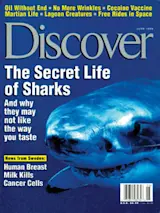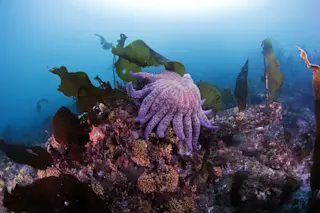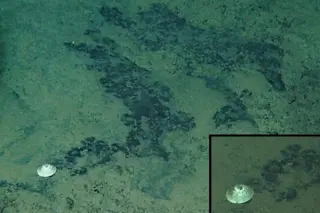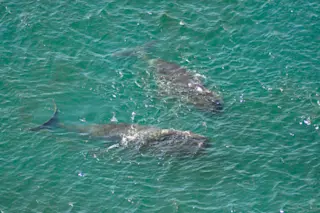Rodney Orr was having a good day. By noon on that breezy Saturday in September nine years ago, the Santa Rosa, California, electrician was spearfishing 50 miles up the coast from San Francisco and had already taken his limit of abalone, so he decided to go for black snapper and ling. He kicked away from his fiberglass paddleboard and took a deep breath when suddenly he felt as if a boat had run over him. "I was ready to turn and make a dive, then the lights went out," Orr recalls. "All I heard was a big crunch, kind of like a garage door closing."
For a second or two he was enveloped in darkness, in water blackened with blood. Then it cleared and a glint of sunlight revealed rows of white teeth. As they pierced an eyelid and cheekbone on the left side of his face and ripped across his nose, he felt other teeth buried in his neck. Orr realized his entire head was in the grip of a shark. Then he saw the sea flashing below. "The shark had me up out of the water," he says. "And the sea was kind of flying by."
Orr flailed at the great white with his speargun in one hand and beat against the creature's teeth with his other hand, but the shark held his skull in a chillingly impassive grip as it thrashed him from side to side. Ten seconds after the attack began, it ended. "All of a sudden, I just popped out of the shark's mouth," says Orr. "He just let me go. When he went down I saw part of his head, and it was wider than my shoulders." Orr swam back to his paddleboard, a trail of blood marking the 60 or 70 feet the shark had carried him, and then paddled for shore as he tried to keep from passing out. He was picked up by a helicopter summoned by a passing highway patrolman, and by 10 P.M. he was home with nearly 80 stitches mapping the grisly encounter. Today, at age 58, Orr jokes that his scars blend with the weathering of his face. "The way the wrinkles went, that's the way the scars went," he says. "So I lucked out."
Why Orr survived--as do most human shark-attack victims--is one of the mysteries surrounding the great white shark, among the least understood of Earth's creatures. Even the size of great white populations--now a protected species in South Africa, Australia, and parts of the United States--is unknown. Scientists have seen as many as 18 sharks at one hunting ground off the California coast but won't hazard a guess about how many more there might be. "The problem is that we only see sharks when they make active attacks on prey," says ichthyologist Peter Klimley of the University of California at Davis.
The popular view of great whites--which most scientists refer to simply as whites--is at odds with the little that is known about them. Far from being the mindless killing machines of Jaws fame, they seem to observe social customs and rituals and appear to be particular about what they eat. They grow to 20 feet and more and can reach a weight of 5,000 pounds. Unlike most fish, they are born live, hatching inside the mother and emerging into the world five-and-a-half-feet long. But even basic information such as how and where the white shark mates remains unknown.
Scientists are struggling to paint a better picture. For the first time, marine biologists, using a sophisticated computer-tracking system linked to ultrasonic transmitters planted in the hide of the shark, are able to follow its underwater movements round-the-clock as it cruises a favorite hunting ground off the California coast. Scientists hope that Añother instrument, placed in the gut of the fish, will reveal where and when a shark eats--and how humans can avoid being on the menu. Study of the great white shark has broader implications, too. The white is an apex predator at the top of the food chain, so a change in white shark numbers is likely to ripple throughout the oceanic ecosystem. To cite just one example: sharks eat seals and seals eat salmon. Therefore, a drop in shark populations, leading to an increase in seals, could show up in a depletion of salmon fisheries.
The laboratory for this new research is located 23 miles from Santa Cruz, California, off the tiny island of Año Nuevo. The spot is convenient because each fall, great whites swarm to this rocky outcrop, presenting biologists with an unparalleled opportunity. Nearby waters, with waves of 10 to 15 feet, are perhaps best known for surfing. But the sere and barren island--in a coastal area discovered by Spanish explorers in 1603--is also a prime breeding ground for the northern elephant seal, one of the world's largest pinnipeds. With a sloping shelf that eases the access from water to land, the island is a breeding ground from December to March for some 8,000 northern elephant seals. For marine mammal enthusiasts, Año Nuevo Island is an extravagant spectacle, with huge seal beachmasters fighting for control of female harems. For mature great whites, it's dinner.
"An elephant seal rookery like Año Nuevo is a supermarket for whites," says Burney Le Boeuf, a University of California at Santa Cruz behavioral ecologist and a leading expert on pinnipeds. "It's stationary, it's open 24 hours a day, and it's full of things they like to eat." Le Boeuf reasoned that to further his understanding of pinnipeds he needed a clearer picture of their relationship to their main adversary. So in 1996 he teamed up with Klimley in hopes of penetrating the secret life of the great white.
Klimley had previously videotaped more than 100 attacks on elephant seals, sea lions, and harbor seals at the Farallon Islands, a group of rocky islets west of San Francisco. The images, some of which should be R-rated for violence, show seals being torn apart. A few are attacked with such enthusiasm that they are decapitated outright. But Klimley also observed that a great white would take a tentative bite of an unfamiliar object, such as a buoy or surfboard, and then spit it out.
At Año Nuevo, Klimley and Le Boeuf observed more examples of such unexpected table manners. The great whites gingerly bit a fake plywood seal. "More often than not, they tended to initially mouth prey candidates delicately rather than just munch down," says Le Boeuf. "They're very particular about what they bite into. I have an intuitive sense that they have a soft mouth, like bird dogs. They get a tremendous amount of information from their mouths."
Klimley theorizes that the jaws and teeth of a white are an exquisite tensiometer. He suspects a white can tell the relative fat content of an animal by first mouthing it gently; if the tensile resistance associated with blubber is revealed, the shark goes for a full-strength bite. If not, it will back off to save its energy for a more nutritious meal. "That's probably why most humans who are bitten are seldom killed," says Klimley. A human has too much muscle and not enough fat for a great white. The same calculation, he argues, may factor into the white's rejection of other potential prey. "We sometimes find sea otters floating dead with white teeth fragments stuck in their flesh," says Klimley. "Unlike other marine mammals, sea otters rely on dense pelts rather than blubber to conserve warmth. From a white's perspective, the lack of fat makes them an undesirable meal. So after a shark mouths an otter, it tends to spit it out."
Great whites might favor fat because they burn prodigious amounts of calories. In the early 1980s the late Frank Carey, an ichthyologist at the Woods Hole OceAñographic Institution, put a temperature probe in the muscle of a great white and found that the shark's body temperature was higher than the surrounding water. A few years later John McCosker, an ichthyologist at the California Academy of Sciences, induced a great white to swallow a temperature probe buried in a slab of seal blubber and confirmed Carey's startling discovery: like only a few other fish--porbeagles and mako sharks and tuna--the great white is warm-blooded. "They seem quite adept at regulating their body temperatures," says Klimley. "So far, the maximum differential we've found has been 15 degrees [Celsius] above the temperature of the surrounding water. That's pretty impressive."
Maintaining a warm core temperature allows great whites to cruise on extended hunts, make numerous and concerted dashes at prey, and bite elephant seals to death in furious combat. But warm-bloodedness could place great energy demands on an animal that lives in cold environs. So for great whites, fat, which contains nine calories per gram compared with four for protein and carbohydrates, is the good life. "To a white, elephant seals are the PowerBars of the sea," says Klimley.
Not all shark experts agree with Klimley's hypothesis. Ichthyologist George Burgess, director of the International Shark Attack File at the Florida Museum of Natural History, notes that in a third of the attacks on humans, the white shark returns for a second bite. Burgess thinks more victims would become shark food were it not for speedy rescue intervention.
Technology may help resolve the debate. A new tracking system had its genesis in individual acoustic tags used by Klimley and his associates in the mid-1990s. Tagged sharks were tracked for an hour or two a day using a hydrophone, an underwater microphone, hung over the side of a boat. In 1997 Klimley and Le Boeuf replaced the handheld hydrophone with a triangle of sonobuoys, placed some 550 yards apart, in an area where they had observed shark attacks off the western shore of Año Nuevo. The idea was that a single buoy would capture the signal of any tagged shark that came within a range of about 1,100 yards, and triangulation would pinpoint the shark's exact location when it came within range of all three buoys. This data would be relayed to a computer on Año Nuevo where the movement of the sharks could be plotted in real time. The beauty of the system was that it could track great whites continuously, day and night, without a human at the controls.
The next job was to tag the sharks--a dicey maneuver handled by Sean Van Sommeran, executive director of the Pelagic Shark Research Foundation in Santa Cruz, that required planting a half-inch barbed dart fitted with an ultrasonic transmitter at the base of the shark's dorsal fin. To entice the great white to come close to the tagging boat, Van Sommeran devised a lure: a large piece of plywood cut in the shape of an elephant seal. He painted the underside brown (and white on top so it could be tracked more easily), smeared it with seal or whale blubber taken from carcasses left by sharks, and drifted the boat slowly through the waters off Año Nuevo with the decoy trailing by 100 yards.
Stimulated by the silhouette and the scent of meat, the great whites investigated. Sometimes they nipped; other times they nudged the lure with their snouts or mouthed it tentatively. Once a shark's interest had been engaged, the tagging crew would gradually reel in the lure until it was alongside the stern of the boat. If the shark continued to sniff out the dubious entree, Van Sommeran or one of his crew would have time to plant the transmitter. This was done by jabbing the barbed dart, attached to the end of a seven-foot lance, into the shark.
Van Sommeran, who has logged more than 20 years on the water--first as a deckhand on commercial tuna boats and in the past decade as a shark field researcher--regards the great white as an animal of uncanny intelligence. "Their ambush behavior is tactical in nature," Van Sommeran says. "They actually spy-hop [a maneuver in which the fish holds its head out of the water] and breach like whales. It's common for them to swim up to the stern of the boat, stick their heads out of the water, and look at the chum bag. And then us."
The tagging season is restricted to about two months in midfall when the waters off California's central coast are atypically placid. "Año Nuevo's surf is usually incredibly rough," says Klimley. "The window for actually getting out there and doing the necessary fieldwork is pretty narrow." Five sharks were tagged in the fall of 1997.
As the transmitters on the sharks sent back data, for the first time ever, researchers could observe in real time the pathways of more than one great white as they moved beneath the opaque murk of the Pacific Ocean off Año Nuevo. In the months since, a portrait of the great whites as hunters has gradually come into focus. Contrary to the commonly held belief that the sharks confine their hunting to daytime, the research team discovered that hunting occurs around the clock. Great whites are clearly relentless, and preliminary data suggest they may also be crafty. "The sharks appear to attack from ambush," says Klimley. "From a seal's perspective, the dark gray of the sharks' backs could blend almost perfectly with a rocky bottom, and heavy surf could further serve to obscure them. The area of the highest attacks at Año Nuevo is one that provides them perfect camouflage."
Great whites are not the lone wolves of the sea some researchers had thought them to be. "Specific sharks spent significantly more time with some sharks than other sharks," Le Boeuf says. "It was clear some kind of bonding had occurred." While great whites appear to hunt independently, tracking data revealed Añother kind of social behavior: one shark may approach the prey of Añother but then quickly leave. During his previous research at the Farallon Islands, Klimley observed similar behavior after a great white killed a small- to medium-size seal--a one-shark meal, in other words. It then would often engage in energetic tail-slapping that Klimley interpreted as a signal to other sharks to stay away. "I began applying values of zero or one to different aspects of the tail slap," he says. "How high, how far, how long the tail is in the air, the number of splashes. If the tail-slapping reached a certain numeric level, inquisitive sharks shied away from the feeding shark. It was apparent the feeding shark was saying, 'This is mine--keep your distance.' "
Last October, in an effort to monitor even more precisely when and where a shark eats warm-blooded prey, the research team buried a transmitter with a barbed hook in a parcel of seal meat that was fed to a great white dubbed Top-Notch. The transmitter relayed data for 13 days on her stomach temperature and location to the sonobuoys. Top-Notch did not feast on any seals or sea lions before she left the area. But this fall, the scientists plan to place transmitters in the guts of five to eight sharks in hopes of learning more. "Knowing how sharks eat could help us learn ways to avoid being attacked by them," says Klimley.
The researchers' next objective is to find out what sustains Año Nuevo's white sharks once pinniped breeding season ends and the elephant seals disperse. Klimley believes it's unlikely the seals are hunted in the open sea, since they spend much of their time diving for squid. One theory is that great whites lock onto the migration paths of the gray whale. "A lot of gray whales expire from any number of causes during the migration, so you have a lot of carcasses floating around out there," says Klimley. "And the ones that wash up usually show evidence of white scavenging."
Out there, of course, is a big place. "They can travel great distances and arrive at a particular site precisely when specific prey animals arrive," he adds. But how? Klimley thinks the great whites are guided by two faculties: a keen sense of smell and an amazing set of navigational tools. "We know that whites have one of the largest olfactory bulbs of any fish," he says. "It might allow them to detect minute fractions of carrion at great distances." He speculates that great whites also possess a biological clock and a heightened spatial sense. Together, these mechanisms could guide the sharks through a featureless murk to arrive at the same time each year at specific coordinates on a global map.
To test this theory, Klimley and Le Boeuf would like to set up a large array of solar-powered buoys along the 70 miles from Año Nuevo to the Farallons to Point Reyes. And Klimley is now working with engineers to design a new system with the ultimate white-shark tag--one that would record and store location data wherever the sharks traveled, then dump this information whenever they got within range of a buoy. "That," says Klimley, "should give us a very textured picture of shark behavior."
No matter how successful the research team is in penetrating the secret life of the great white, its power to terrify is unlikely to disappear--especially from up close. Rodney Orr still spearfishes, but getting shark bit left an indelible impression. "You find out how small and defenseless you are," he says. "You're like a soda cracker floating around out there. The shark is an awesome creature."
------------------------------------------------------------------------
Jaws Unhinged
Thank Steven Spielberg and Peter Benchley for the lousy reputation of white sharks. In Spielberg's 1975 movie Jaws, based on Benchley's best-selling book, Matt Hooper, the shark expert played by Richard Dreyfuss, describes the villainous great white as a "rogue" feeding on easy human prey and defending its territory. "There is no viable rogue shark theory," says Sean Van Sommeran of the Pelagic Shark Research Foundation in Santa Cruz, California. "It's a holdover from old tiger theories--when a tiger would be injured and unable to hunt its regular territory, it would hang around areas where people lived. Sharks don't do that." As for a white shark attacking a boat in a pond near the beach--that has never happened. The final scene of Jaws--the hunt and kill--is pure fiction. The shark is speared with a roped harpoon and drags first one, then two, and finally three barrels as the humans try to shoot it. Barrel dragging is a shark-hunting method, but sharks typically swim away, realize they're caught, and then twist and fight, ultimately becoming tangled in the ropes. They do not drag the barrels for hours and bide their time until they can strategically attack. When sharks are shot point-blank with a pistol, they usually retreat. The most ludicrous shark behavior in the film comes after police chief Martin Brody (Roy Scheider) heaves an oxygen tank into the beast's mouth. Minutes later, Scheider shoots the tank, still in the shark's mouth, and both tank and shark explode. Van Sommeran's reaction: "A shark would never swim around with a tank clamped in its jaws like a cigar." --Wendy Marston
------------------------------------------------------------------------
Shark Avoidance
The easiest way to avoid being bit by a great white is to steer clear of the sharks' hunting grounds: locations along the California coast frequented by large colonies of seals and sea lions. Shark experts say water-sports enthusiasts who venture near such areas should surf, swim, or dive with friends; a group of people might keep a shark away and will insure a quick rescue. Divers and spearfishermen should avoid lingering near the surface, where most great white victims are attacked, and stay away from rocky areas underwater where the black back of the great white could be difficult to distinguish from the ocean floor. Some researchers believe a black wet suit might cause a great white to mistake a person for a seal. But the sharks have also been known to attack people dressed in a variety of colors, including what scientists call "yum-yum" yellow. "One of the biggest misconceptions is, 'If I'm not wearing a black wet suit, I'm safe,' " says shark expert Peter Klimley. "No. No. No." --Jessica Gorman
------------------------------------------------------------------------
Man-killer?
Great whites are frequently maligned as bloodthirsty man-eaters but in fact rarely kill people. Worldwide there have been 245 documented attacks on humans and 64 fatalities since 1876, says George Burgess of the International Shark Attack File at the Florida Museum of Natural History. Along the California coast there have been 78 attacks and just 8 deaths since the first documented incident in 1926. One reason the numbers are so low might be that great whites hunt in numbingly cold waters where they rarely come across humans. Burgess says attacks have actually increased slightly in recent years as a growing number of people have donned wet suits and ventured too close to shark hunting grounds, yet fatality rates continue to drop. Worldwide, 92 percent of the white shark attacks before 1950 were fatal. During the 1950s the fatality rate dropped to 50 percent, and in recent years it has plummeted to 15 percent. Burgess suggests that people--unlike seals or sea lions--have a better chance of surviving shark attacks because they are whisked out of the water quickly. The drop in fatality rates, he argues, "reflects our ability to have help at hand to save and rescue victims." --Jessica Gorman














